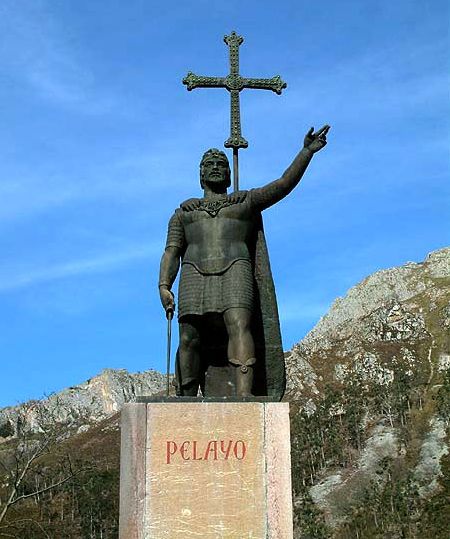
Before starting with the History section, let's review some important aspects. I am sure it will help you to update and renew your skills.
TOPIC
|
ACTIVITY
|
MULTIMEDIA
|
WHAT IS HISTORY?
|
||
WHY IS HISTORY IMPORTANT?
|
||
WHAT PERIOD OF HISTORY DID YOU STUDY LAST YEAR?
|
Speak up and try to remember.
|
Ancient Rome |
LET’S REVIEW CHRONOLOGY
|
||
THE HISTORICAL PERIODS
|
||
YOU ALSO HAVE A PAST
|
||
WHAT ABOUT GEOGRAPHY?
|
As well as time, be able to locate past events is fundamental.
Do you remember the political and physical map of Europe?
|
UNIT 1.THE EARLY MIDDLE AGES. GERMANIC KINGDOMS
AND THE BYZANTINE EMPIRE

TOPIC
|
PRESENTATIONS
|
SOURCES
|
MULTIMEDIA
|
This
unit begins the study of the Middle Ages by connecting it which the end of
the ancient world and establishing its historical period between the 5th
and the 15th centuries. The first stage we will study is the Early
Middle Ages (Alta Edad Media). This period is addressed for two great territorial areas after the
fall of the Roman Empire: The
Byzantine Empire in the East and the Germanic
kingdoms in the West.
|
POWER
POINT PRESENTATIONS
|
||
VOCABULARY
|
|||
ART
|
|||
INFORMATION ABOUT THE EXAM:
1. Vocabulary. I recommend the use of Quizlet. 4 terms from the set of vocabulary of the class.
2. Chronology. Match dates with the corresponding historical events.
3. Practice. It can be a map, an image or a text. In the first units it is obvious that it will be a map.
4. Questions
5. A topic. (Tema a desarrollar)
UNIT 2. ISLAM

TOPIC
|
PRESENTATIONS
|
SOURCES
|
MULTIMEDIA
|
Islam is the term that designates a new religion that started when Muhammad got the first revelations from Allah, This medieval monotheistic religion will gain hundreds of followers in a short period of time, expanding from East to West and reaching the Iberian Peninsula in 711.
| |||
VOCABULARY
| |||
ART
| |||
MAPS REVIEW | |
THE PHYSICAL MAP OF EUROPE
| |
THE POLITICAL MAP OF EUROPE
| |
THE PHYSICAL MAP OF SPAIN
|
Rivers and tributaries (we will select them in class)
Slection of rivers and tributaries: Miño, Nalón, Duero (Esla, Tormes, Pisuerga), Tajo (Jarama, Henares, Tiétar), Guadiana (Jabalón, Ciguela), Odiel, Guadalquivir, Guadalete, Ter, Llobregat, Turia, Júcar, Segura. |
THE POLITICAL MAP OF SPAIN
| |
UNIT 3.THE EARLY MIDDLE AGES. The beginning of feudalism.


TOPIC
|
PRESENTATIONS
|
SOURCES
|
MULTIMEDIA
|
The feudal system comes into focus during the 8th century, when the Carolingian dynasty is expanding its territory. Charles Martel grants his nobles rights over tracts of land, to yield the income with which they can provide fighting men for his army. This act of generosity, ultimately for his own benefit, requires an oath of loyalty in return.
Thus there develops the relationship between lord and vassal which is at the heart of feudalism. The lord gives the vassal an income-yielding fief (fehu-odin Frankish, the basis of the word 'feudal'). | Website created by the teacher: FEUDALISM IN EUROPE Click on historical map to do the activity about foreign invasions 700-1000. | ||
VOCABULARY
| |||
ART
| |||
UNIT 4. THE IBERIAN PENINSULA BETWEEN THE 8th AND THE 11th CENTURIES

TOPIC
|
PRESENTATIONS
|
SOURCES
|
MULTIMEDIA
|
In this unit you will have the opportunity to learn a very interesting and important chapter of our History: the beginning of the Reconquest. Between the 8th and the 11th centuries two civilizations with a complete different culture and traditions were forced to coexist in the Iberian Peninsula: the Muslims in Al-Andalus and the Christian resistance from the Cantabrian Mountains to the Duero Valley and the area around the Pyrenees. |
Working with the teaching assistant: The phases of the Reconquest project
| Reading: "La lección de Ajedrez" Once you read it create a summary of 5 lines and a personal opnion of 3 lines. | |
VOCABULARY
|
https://quizlet.com/69360090/unit-4-the-iberian-peninsula-between-the-8th-and-the-11th-centuries-flash-cards/
Note for 2ºB: I was confussed and mistaken, and, before, you had a few words and the half belonged to another unit, sorry. Now it is perfect. So please create flashcards according to these terms rearranged. | ||
ART
| |||
UNIT 5. THE HIGH MIDDLE AGES. URBAN RENAISSANCE

TOPIC
|
PRESENTATIONS
|
SOURCES
|
MULTIMEDIA
|
Reading comprehension:
Bird's eye view of Paris from the book The Hunchback of Nôtre Dame + activities from Friday | |||
VOCABULARY
| |||
ART
| |||
UNIT 6. IBERIAN PENINSULA BETWEEN THE 11th and 13th CENTURIES

TOPIC
|
PRESENTATIONS
|
SOURCES
|
MULTIMEDIA
|
EXAM --> |
NOTE-TAKING FROM CLASS ANSWER KEY UNIT 6 Answers to the activities, so you can correct everything at home if there is any doubt while I am out. |
| |
VOCABULARY
| |||
ART
| |||
Note: Cortes de León text plus questions are in the sources box
UNIT 7. THE LATE MIDDLE AGES. CRISIS AND RECOVERY

TOPIC
|
PRESENTATIONS
|
SOURCES
|
MULTIMEDIA
|
In this unit we will have the opportunity to study the economic crisis of the 14th century and one of the worst epidemics in the world: The Black Death. Also the cultural and the artistic manifestations of this period such as the Mediterranean Gothic or the Flamboyant Gothic.
|
|
| |
VOCABULARY
| |||
ART
| |||
 GEOGRAPHY
GEOGRAPHY
UNIT 1: INTRODUCTION
POLITICAL MAPS. 2º ESO
Resources for studying maps
WORLD ATLAS. This resource is very useful to know more about each continent, including all the political maps. Amazing tool for the students!
|
UNIT 2: WORLD POPULATION
Population from almusociales
.
SET OF ACTIVITIES FROM THE BOOK
CHAPTER 1 (PPT)
Page 155, number 2
CHAPTER 2 (PPT)
Page 150, number 1 and 2
CHAPTER 3 (PPT)
All formulas are on page 152 and you must learn them plu the indicators: low, medium, high
Page 152, number 1 and 2
Page 154, number 1
For practicing more if you want :
CHAPTER 4 (PPT)
Look at the map on page 161 and answer the following questions:
What are the destinations of qualified migrants? And unqualified emigrants? Why?
CHAPTER 5 (PPT)
Page 157, number 2 and 3
More information in pages 157 and 166
La segunda persona más longeva del mundo
CHAPTER 1 (PPT)
Page 155, number 2
CHAPTER 2 (PPT)
Page 150, number 1 and 2
CHAPTER 3 (PPT)
All formulas are on page 152 and you must learn them plu the indicators: low, medium, high
Page 152, number 1 and 2
Page 154, number 1
For practicing more if you want :
|
|
Number of births
|
Number of deaths
|
Total population
|
Birth rate
|
Death rate
|
Natural growth
|
|
GERMANY
|
711 220
|
818 730
|
82 700 000
|
|
|
|
|
ANGOLA
|
756 040
|
406 720
|
16 400 000
|
|
|
|
CHAPTER 4 (PPT)
Look at the map on page 161 and answer the following questions:
What are the destinations of qualified migrants? And unqualified emigrants? Why?
CHAPTER 5 (PPT)
Page 157, number 2 and 3
More information in pages 157 and 166
La segunda persona más longeva del mundo
REINFORCE ACITIVITIES
In this webpage of the INE (Instituto Nacional de Estadística) we can have a look to the different population pyramids of our country through the last centrury. Click on the logo :)
3. Select two pyramids of Spain from the above link and compare both. Piece of writing between 10 and 20 lines
DEMOGRAPHIC DESERTS
MIGRATORY MOVEMENTS
Population pyramid
analysis
Introduction: This is
the population pyramid of ………in the year……..A population pyramid is a graph of bars that depicts the structure of the population of a certain place and time according to the gender and groups of age.
SHAPE: triangular/bell / urn showing a expansive/stationary or contractive pyramid.
Top: narrow/wide. Why? Give evidence. Ageing population, life expectancy is high/low, why?
Top: narrow/wide. Why? Give evidence. Ageing population, life expectancy is high/low, why?
Base: norrow/wide. Why? Give evidence. The number
of births is high/low, why? Explanatory facts such as ..childern contribute to the family
income, are they an economic burden, etc.
Predict
future pyramids
This population pyramid is characteristic of…………………………countries.

No hay comentarios:
Publicar un comentario